章节目录:
一、概述
在
Java中线程安全集合类可以分为三大类。
- 遗留的线程安全集合:
Hashtable、Vector; Collections装饰的线程安全集合:
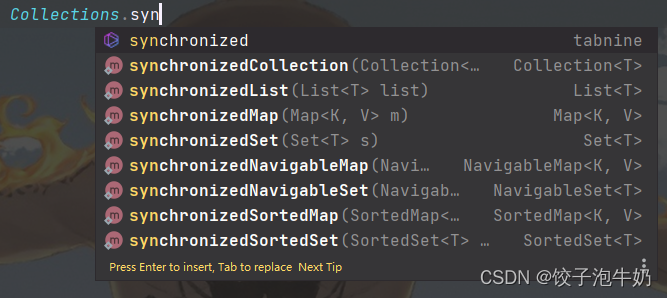
java.util.concurrent.*下的线程安全集合类,其中包含的又有以下三类关键词:
-
Blocking:大部分实现基于锁,并提供用来阻塞的方法。
-
CopyOnWrite:之类容器修改开销相对较重。
-
Concurrent:类型的容器,内部很多操作使用
cas优化,一般可以提供较高吞吐量,另外它还有弱一致性的特点:- 遍历时弱一致性,例如,当利用迭代器遍历时,如果容器发生修改,迭代器仍然可以继续进行遍历,这时内容是旧的;
- 求大小弱一致性,size 操作未必是 100% 准确;
- 读取弱一致性。
二、ConcurrentHashMap
2.1 并发问题
- 代码示例:
public class Demo {
private static final String ALPHA = "abcedfghijklmnopqrstuvwxyz";
private static final List<String> TEST_DATA = new ArrayList<>();
static {
int length = ALPHA.length();
int count = 100;
int capacity = length * count;
List<String> list = new ArrayList<>(capacity);
for (int i = 0; i < length; i++) {
// 拿到每个字母。
char c = ALPHA.charAt(i);
for (int j = 0; j < count; j++) {
// 添加字母各一百次到集合中。
list.add(c + "");
}
}
// 将集合中元素随机重排序。
Collections.shuffle(list);
TEST_DATA.addAll(list);
}
/**
* 获取计数结果。
*
* @param threadNum 线程数。
* @param sup 供给型函数式接口。
* @param cons 消费型函数式接口。
*/
private static <V> void getCount(
int threadNum,
Supplier<Map<String, V>> sup,
BiConsumer<Map<String, V>, List<String>> cons
) {
Map<String, V> map = sup.get();
List<Thread> threads = new ArrayList<>();
for (int i = 0; i < threadNum; i++) {
Thread t = new Thread(() -> cons.accept(map, TEST_DATA));
threads.add(t);
}
threads.forEach(Thread::start);
threads.forEach(t -> {
try {
t.join();
} catch (InterruptedException e) {
e.printStackTrace();
Thread.currentThread().interrupt();
}
});
System.out.println(map);
}
/**
* 方式一:使用非线程安全的 `map` 并发读取。
*/
@Test
public void test02() {
getCount(
2,
() -> new HashMap<String, Integer>(),
(map, words) -> {
for (String word : words) {
Integer counter = map.get(word);
int newValue = counter == null ? 1 : counter + 1;
map.put(word, newValue);
}
}
);
// {a=193, b=192, c=196, d=197, e=193, f=193, g=195, h=195, i=193,
// j=192, k=196, l=193, m=191, n=192, o=198, p=192, q=197, r=193,
// s=192, t=175, u=194, v=193, w=193, x=195, y=191, z=195}
}
/**
* 方式二:使用 `ConcurrentHashMap` 并发读取。
*/
@Test
public void test03() {
getCount(
2,
() -> new ConcurrentHashMap<String, Integer>(),
(map, words) -> {
for (String word : words) {
// 函数式编程,无需原子变量。
map.merge(word, 1, Integer::sum);
}
}
);
// {a=200, b=200, c=200, d=200, e=200, f=200, g=200, h=200, i=200,
// j=200, k=200, l=200, m=200, n=200, o=200, p=200, q=200, r=200,
// s=200, t=200, u=200, v=200, w=200, x=200, y=200, z=200}
}
}
2.2 重要属性和内部类
备注:此处示例为
JDK 8版本,数组简称(table),链表简称(bin)。
// 默认为 0
// 当初始化时, 为 -1
// 当扩容时, 为 -(1 + 扩容线程数)
// 当初始化或扩容完成后,为 下一次的扩容的阈值大小
private transient volatile int sizeCtl;
// 整个 ConcurrentHashMap 就是一个 Node[]
static class Node<K,V> implements Map.Entry<K,V> {}
// hash 表
transient volatile Node<K,V>[] table;
// 扩容时的 新 hash 表
private transient volatile Node<K,V>[] nextTable;
// 扩容时如果某个 bin 迁移完毕, 用 ForwardingNode 作为旧 table bin 的头结点
static final class ForwardingNode<K,V> extends Node<K,V> {}
// 用在 compute 以及 computeIfAbsent 时, 用来占位, 计算完成后替换为普通 Node
static final class ReservationNode<K,V> extends Node<K,V> {}
// 作为 treebin 的头节点, 存储 root 和 first
static final class TreeBin<K,V> extends Node<K,V> {}
// 作为 treebin 的节点, 存储 parent, left, right
static final class TreeNode<K,V> extends Node<K,V> {}
2.3 重要方法
// 获取 Node[] 中第 i 个 Node
static final <K,V> Node<K,V> tabAt(Node<K,V>[] tab, int i)
// cas 修改 Node[] 中第 i 个 Node 的值, c 为旧值, v 为新值
static final <K,V> boolean casTabAt(Node<K,V>[] tab, int i, Node<K,V> c, Node<K,V> v)
// 直接修改 Node[] 中第 i 个 Node 的值, v 为新值
static final <K,V> void setTabAt(Node<K,V>[] tab, int i, Node<K,V> v)
2.4 构造器
实现了懒惰初始化,在构造方法中仅仅计算了
table大小,之后会在第一次使用时才会真正的创建。
/**
* Creates a new, empty map with an initial table size based on
* the given number of elements ({@code initialCapacity}), table
* density ({@code loadFactor}), and number of concurrently
* updating threads ({@code concurrencyLevel}).
*
* @param initialCapacity the initial capacity. The implementation
* performs internal sizing to accommodate this many elements,
* given the specified load factor.
* @param loadFactor the load factor (table density) for
* establishing the initial table size
* @param concurrencyLevel the estimated number of concurrently
* updating threads. The implementation may use this value as
* a sizing hint.
* @throws IllegalArgumentException if the initial capacity is
* negative or the load factor or concurrencyLevel are
* nonpositive
*/
public ConcurrentHashMap(int initialCapacity,
float loadFactor, int concurrencyLevel) {
if (!(loadFactor > 0.0f) || initialCapacity < 0 || concurrencyLevel <= 0)
throw new IllegalArgumentException();
if (initialCapacity < concurrencyLevel) // Use at least as many bins
initialCapacity = concurrencyLevel; // as estimated threads
// tableSizeFor 保证计算大小是(2^n):即16、32、64...
long size = (long)(1.0 + (long)initialCapacity / loadFactor);
int cap = (size >= (long)MAXIMUM_CAPACITY) ?
MAXIMUM_CAPACITY : tableSizeFor((int)size);
this.sizeCtl = cap;
}
2.5 get 流程
/**
* Returns the value to which the specified key is mapped,
* or {@code null} if this map contains no mapping for the key.
*
* <p>More formally, if this map contains a mapping from a key
* {@code k} to a value {@code v} such that {@code key.equals(k)},
* then this method returns {@code v}; otherwise it returns
* {@code null}. (There can be at most one such mapping.)
*
* @throws NullPointerException if the specified key is null
*/
public V get(Object key) {
Node<K,V>[] tab; Node<K,V> e, p; int n, eh; K ek;
// spread 方法能确保返回结果是正数。
int h = spread(key.hashCode());
if ((tab = table) != null && (n = tab.length) > 0 &&
(e = tabAt(tab, (n - 1) & h)) != null) {
// 如果头节点已经是要查找的 key。
if ((eh = e.hash) == h) {
if ((ek = e.key) == key || (ek != null && key.equals(ek)))
return e.val;
}
// hash 为负数表示该 bin 在扩容中或是 treebin, 这时调用 find 方法来查找。
else if (eh < 0)
return (p = e.find(h, key)) != null ? p.val : null;
// 正常遍历链表, 用 equals 比较。
while ((e = e.next) != null) {
if (e.hash == h &&
((ek = e.key) == key || (ek != null && key.equals(ek))))
return e.val;
}
}
return null;
}
2.6 put 流程
put():
/**
* Maps the specified key to the specified value in this table.
* Neither the key nor the value can be null.
*
* <p>The value can be retrieved by calling the {@code get} method
* with a key that is equal to the original key.
*
* @param key key with which the specified value is to be associated
* @param value value to be associated with the specified key
* @return the previous value associated with {@code key}, or
* {@code null} if there was no mapping for {@code key}
* @throws NullPointerException if the specified key or value is null
*/
public V put(K key, V value) {
return putVal(key, value, false); // *** putVal() 具体方法说明在下方 ***
}
putVal():
/** Implementation for put and putIfAbsent */
final V putVal(K key, V value, boolean onlyIfAbsent) {
if (key == null || value == null) throw new NullPointerException();
// 其中 spread 方法会综合高位低位, 具有更好的 hash 性。
int hash = spread(key.hashCode());
int binCount = 0;
for (Node<K,V>[] tab = table;;) {
// f 是链表头节点;
// fh 是链表头结点的 hash;
// i 是链表在 table 中的下标。
Node<K,V> f; int n, i, fh;
// 要创建 table。
if (tab == null || (n = tab.length) == 0)
// 初始化 table 使用了 cas, 无需 synchronized 创建成功, 进入下一轮循环。
tab = initTable(); // *** initTable() 具体方法说明在下方 ***
// 要创建链表头节点。
else if ((f = tabAt(tab, i = (n - 1) & hash)) == null) {
// 添加链表头使用了 cas, 无需 synchronized。
if (casTabAt(tab, i, null,
new Node<K,V>(hash, key, value, null)))
break; // no lock when adding to empty bin
}
// 帮忙扩容。
else if ((fh = f.hash) == MOVED)
tab = helpTransfer(tab, f);
else {
V oldVal = null;
// 锁住链表头节点。
synchronized (f) {
// 再次确认链表头节点没有被移动。
if (tabAt(tab, i) == f) {
if (fh >= 0) {
binCount = 1;
// 遍历链表。
for (Node<K,V> e = f;; ++binCount) {
K ek;
// 找到相同的key。
if (e.hash == hash &&
((ek = e.key) == key ||
(ek != null && key.equals(ek)))) {
oldVal = e.val;
// 值更新。
if (!onlyIfAbsent)
e.val = value;
break;
}
Node<K,V> pred = e;
// 已经是最后的节点了, 新增 Node, 追加至链表尾。
if ((e = e.next) == null) {
pred.next = new Node<K,V>(hash, key,
value, null);
break;
}
}
}
// 红黑树。
else if (f instanceof TreeBin) {
Node<K,V> p;
binCount = 2;
// putTreeVal 会看 key 是否已经在树中, 是, 则返回对应的 TreeNode。
if ((p = ((TreeBin<K,V>)f).putTreeVal(hash, key,
value)) != null) {
oldVal = p.val;
if (!onlyIfAbsent)
p.val = value;
}
}
}
// 释放链表头节点的锁。
}
if (binCount != 0) {
if (binCount >= TREEIFY_THRESHOLD)
// 如果链表长度 >= 树化阈值(8), 进行链表转为红黑树。
treeifyBin(tab, i);
if (oldVal != null)
return oldVal;
break;
}
}
}
// 增加 size 计数。
addCount(1L, binCount); // *** addCount() 具体方法说明在下方 ***
return null;
}
initTable():
/**
* Initializes table, using the size recorded in sizeCtl.
*/
private final Node<K,V>[] initTable() {
Node<K,V>[] tab; int sc;
while ((tab = table) == null || tab.length == 0) {
if ((sc = sizeCtl) < 0)
Thread.yield(); // lost initialization race; just spin
// 尝试将 sizeCtl 设置为 -1(表示初始化 table)。
else if (U.compareAndSwapInt(this, SIZECTL, sc, -1)) {
// 获得锁, 创建 table, 这时其它线程会在 while() 循环中 yield 直至 table 创建。
try {
if ((tab = table) == null || tab.length == 0) {
int n = (sc > 0) ? sc : DEFAULT_CAPACITY;
@SuppressWarnings("unchecked")
Node<K,V>[] nt = (Node<K,V>[])new Node<?,?>[n];
table = tab = nt;
sc = n - (n >>> 2);
}
} finally {
sizeCtl = sc;
}
break;
}
}
return tab;
}
addCount():
/**
* Adds to count, and if table is too small and not already
* resizing, initiates transfer. If already resizing, helps
* perform transfer if work is available. Rechecks occupancy
* after a transfer to see if another resize is already needed
* because resizings are lagging additions.
*
* @param x the count to add
* @param check if <0, don't check resize, if <= 1 only check if uncontended
*/
// check 是之前 binCount 的个数。
private final void addCount(long x, int check) {
CounterCell[] as; long b, s;
// 已经有了 counterCells, 向 cell 累加。
if ((as = counterCells) != null ||
// 还没有, 向 baseCount 累加。
!U.compareAndSwapLong(this, BASECOUNT, b = baseCount, s = b + x)) {
CounterCell a; long v; int m;
boolean uncontended = true;
// 还没有 counterCells。
if (as == null || (m = as.length - 1) < 0 ||
// 还没有 cell。
(a = as[ThreadLocalRandom.getProbe() & m]) == null ||
// cell cas 增加计数失败。
!(uncontended =
U.compareAndSwapLong(a, CELLVALUE, v = a.value, v + x))) {
// 创建累加单元数组和cell, 累加重试。
fullAddCount(x, uncontended);
return;
}
if (check <= 1)
return;
// 获取元素个数。
s = sumCount();
}
if (check >= 0) {
Node<K,V>[] tab, nt; int n, sc;
while (s >= (long)(sc = sizeCtl) && (tab = table) != null &&
(n = tab.length) < MAXIMUM_CAPACITY) {
int rs = resizeStamp(n);
if (sc < 0) {
if ((sc >>> RESIZE_STAMP_SHIFT) != rs || sc == rs + 1 ||
sc == rs + MAX_RESIZERS || (nt = nextTable) == null ||
transferIndex <= 0)
break;
// newtable 已经创建了,帮忙扩容。
if (U.compareAndSwapInt(this, SIZECTL, sc, sc + 1))
transfer(tab, nt);
}
// 需要扩容,这时 newtable 未创建。
else if (U.compareAndSwapInt(this, SIZECTL, sc,
(rs << RESIZE_STAMP_SHIFT) + 2))
transfer(tab, null);
s = sumCount();
}
}
}
2.7 size 计算流程
size计算实际发生在put,remove改变集合元素的操作之中。- 没有竞争发生,向 baseCount 累加计数。
- 有竞争发生,新建 counterCells,向其中的一个 cell 累加计数:
- counterCells 初始有两个 cell。
- 如果计数竞争比较激烈,会创建新的 cell 来累加计数。
/**
* {@inheritDoc}
*/
public int size() {
long n = sumCount();
return ((n < 0L) ? 0 :
(n > (long)Integer.MAX_VALUE) ? Integer.MAX_VALUE :
(int)n);
}
final long sumCount() {
CounterCell[] as = counterCells; CounterCell a;
// 将 baseCount 计数与所有 cell 计数累加。
long sum = baseCount;
if (as != null) {
for (int i = 0; i < as.length; ++i) {
if ((a = as[i]) != null)
sum += a.value;
}
}
return sum;
}
Java 8 数组(Node) +( 链表 Node | 红黑树 TreeNode ) 以下数组简称(table),链表简称(bin):
- 初始化:使用
cas来保证并发安全,懒惰初始化table; - 树化:当 table.length < 64 时,先尝试扩容,超过 64 时,并且 bin.length > 8 时,会将链表树化,树化过程会用
synchronized锁住链表头; - put:如果该
bin尚未创建,只需要使用cas创建bin;如果已经有了,锁住链表头进行后续put操作,元素添加至bin的尾部; - get:无锁操作仅需要保证可见性,扩容过程中 get 操作拿到的是 ForwardingNode 它会让
get操作在新table进行搜索; - 扩容:扩容时以
bin为单位进行,需要对bin进行synchronized,但这时妙的是其它竞争线程也不是无事可做,它们会帮助把其它bin进行扩容,扩容时平均只有 1/6 的节点会把复制到新table中; - size:元素个数保存在 baseCount 中,并发时的个数变动保存在 CounterCell[] 当中。最后统计数量时累加即可。
2.8 对比 JDK 7 的 ConcurrentHashMap 有什么区别?
- JDK8 中新增了红黑树;
- JDK7中使用的是头插法,JDK8中使用的是尾插法;
- JDK7中使用了分段锁,而JDK8中没有使用分段锁了;
- JDK7中使用了
ReentrantLock,JDK8中没有使用ReentrantLock了,而使用了Synchronized; - JDK7中的扩容是每个
Segment内部进行扩容,不会影响其他Segment,而JDK8中的扩容和HashMap的扩容类似,只不过支持了多线程扩容,并且保证了线程安全。 - 补充说明:JDK6 / 7中的
ConcurrentHashMap主要使用Segment来实现减小锁粒度,把HashMap分割成若干个Segment,在put的时候需要锁住Segment,get时候不加锁,使用volatile来保证可见性,当要统计全局时(比如size),首先会尝试多次计算 modcount 来确定,这几次尝试中,是否有其他线程进行了修改操作,如果没有,则直接返回size。如果有,则需要依次锁住所有的Segment来计算。JDK7中ConcurrentHashmap中,当长度过长碰撞会很频繁,链表的增改删查操作都会消耗很长的时间,影响性能。所以 JDK8 中完全重写了ConcurrentHashMap,代码量从原来的1000多行变成了 6000多行,实现上也和原来的分段式存储有很大的区别。
三、LinkedBlockingQueue
3.1 入队出队
- 入队源码:
public class LinkedBlockingQueue<E> extends AbstractQueue<E>
implements BlockingQueue<E>, java.io.Serializable {
static class Node<E> {
E item;
/**
* One of:
* - the real successor Node
* - this Node, meaning the successor is head.next
* - null, meaning there is no successor (this is the last node)
*/
Node<E> next;
Node(E x) { item = x; }
}
}
- 初始化链表:
last = head = new Node<E>(null);Dummy 节点用来占位,item 为 null。
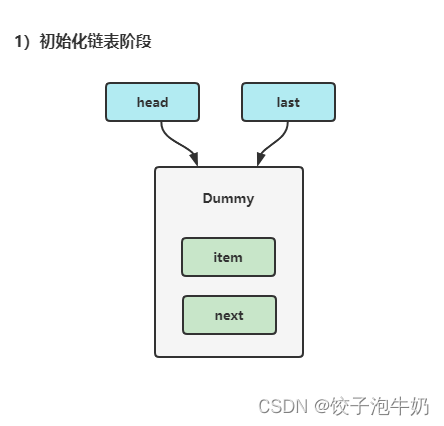
- 当一个节点入队
last = last.next = node;

- 再来一个节点入队
last = last.next = node;

- 出队源码:
/**
* Removes a node from head of queue.
*
* @return the node
*/
private E dequeue() {
// assert takeLock.isHeldByCurrentThread();
// assert head.item == null;
Node<E> h = head;
Node<E> first = h.next;
h.next = h; // help GC
head = first;
E x = first.item;
first.item = null;
return x;
}
- 示意图:
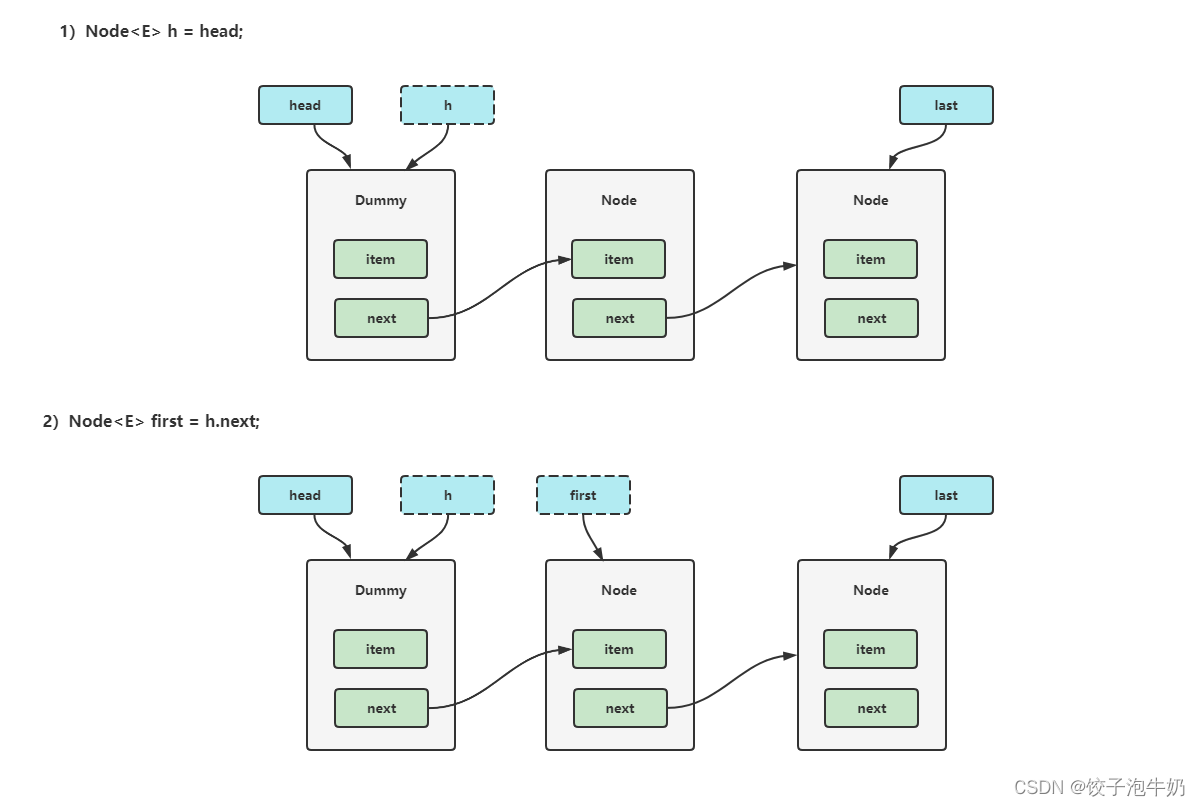
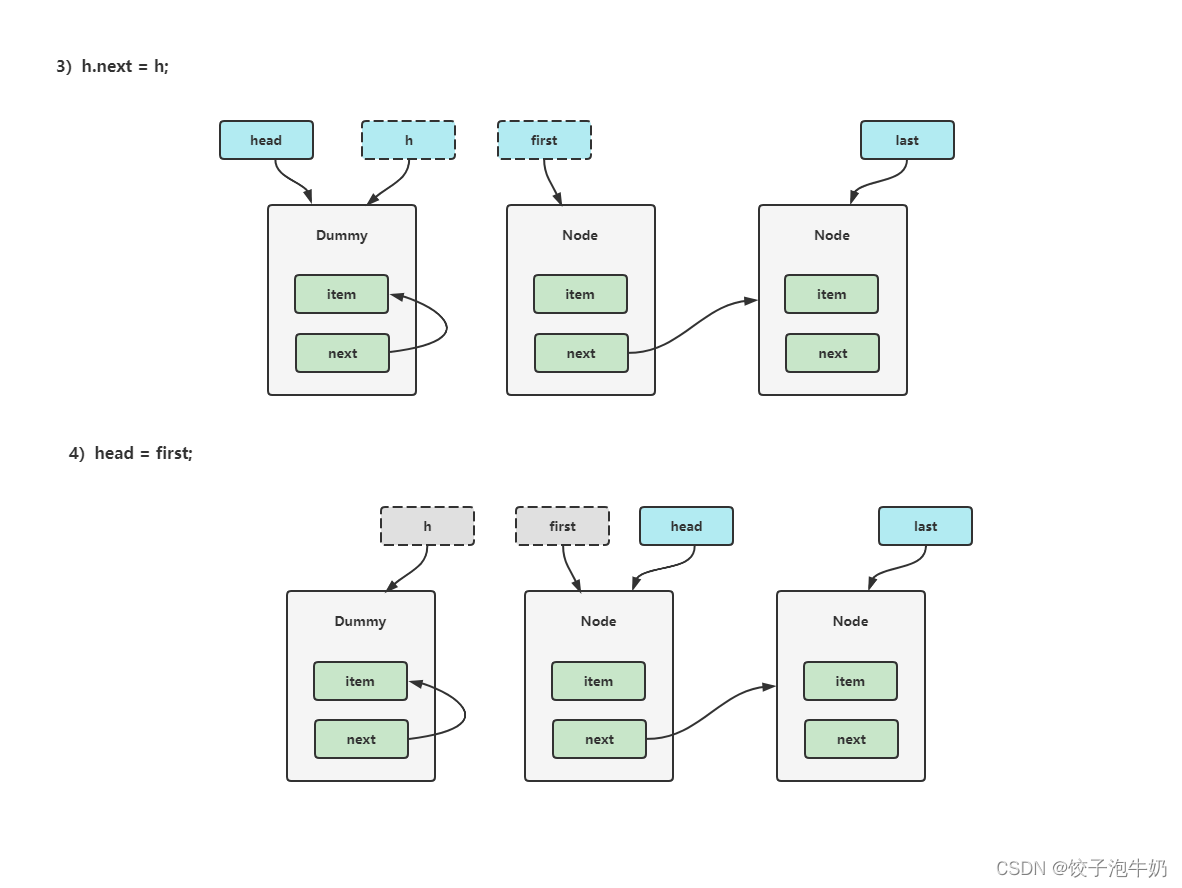
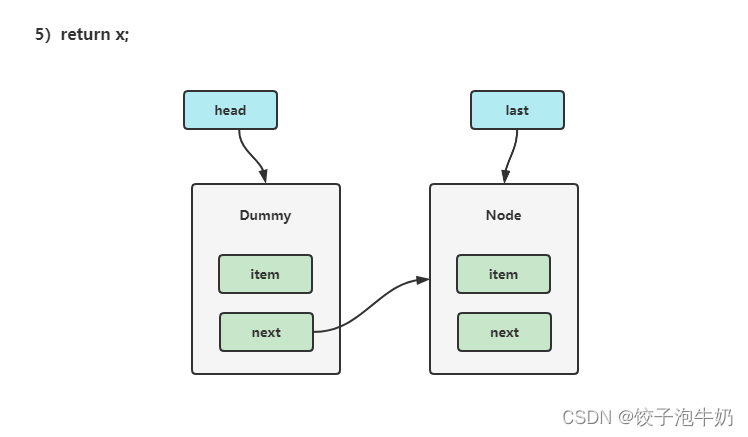
3.2 加锁分析
巧妙之处在于用了两把锁和
dummy(哑元)节点。
-
用一把锁,同一时刻,最多只允许有一个线程(生产者或消费者,二选一)执行。
-
用两把锁,同一时刻,可以允许两个线程同时(一个生产者与一个消费者)执行:
-
消费者与消费者线程仍然串行。
-
生产者与生产者线程仍然串行。
-
/** Lock held by put, offer, etc */
private final ReentrantLock putLock = new ReentrantLock();
/** Lock held by take, poll, etc */
private final ReentrantLock takeLock = new ReentrantLock();
3.3 线程安全分析
-
当节点总数大于 2 时(包括
dummy节点),putLock 保证的是last节点的线程安全,takeLock 保证的是head节点的线程安全。两把锁保证了入队和出队没有竞争。 -
当节点总数等于 2 时(即一个
dummy节点,一个正常节点)这时候,仍然是两把锁锁两个对象,不会竞争。 -
当节点总数等于 1 时(就一个
dummy节点)这时 take 线程会被 notEmpty 条件阻塞,有竞争,会阻塞。
3.4 源码分析
put():
/**
* Inserts the specified element at the tail of this queue, waiting if
* necessary for space to become available.
*
* @throws InterruptedException {@inheritDoc}
* @throws NullPointerException {@inheritDoc}
*/
public void put(E e) throws InterruptedException {
if (e == null) throw new NullPointerException();
// Note: convention in all put/take/etc is to preset local var
// holding count negative to indicate failure unless set.
int c = -1;
Node<E> node = new Node<E>(e);
final ReentrantLock putLock = this.putLock;
// count 用来维护元素计数。
final AtomicInteger count = this.count;
putLock.lockInterruptibly();
try {
/*
* Note that count is used in wait guard even though it is
* not protected by lock. This works because count can
* only decrease at this point (all other puts are shut
* out by lock), and we (or some other waiting put) are
* signalled if it ever changes from capacity. Similarly
* for all other uses of count in other wait guards.
*/
// 满了就等待。
while (count.get() == capacity) {
notFull.await();
}
// 有空位, 入队且计数加一。
enqueue(node);
c = count.getAndIncrement();
// 除了自己 put 以外, 队列还有空位, 由自己叫醒其他 put 线程。
if (c + 1 < capacity)
notFull.signal();
} finally {
putLock.unlock();
}
// 如果队列中有一个元素, 叫醒 take 线程。
if (c == 0)
// 这里调用的是 notEmpty.signal() 而不是 notEmpty.signalAll() 是为了减少竞争。
signalNotEmpty();
}
take():
public E take() throws InterruptedException {
E x;
int c = -1;
final AtomicInteger count = this.count;
final ReentrantLock takeLock = this.takeLock;
takeLock.lockInterruptibly();
try {
while (count.get() == 0) {
notEmpty.await();
}
x = dequeue();
c = count.getAndDecrement();
if (c > 1)
notEmpty.signal();
} finally {
takeLock.unlock();
}
// 如果队列中只有一个空位时, 叫醒 put 线程。
// 如果有多个线程进行出队, 第一个线程满足 c == capacity, 但后续线程 c < capacity。
if (c == capacity)
// 这里调用的是 notFull.signal() 而不是 notFull.signalAll() 是为了减少竞争。
signalNotFull();
return x;
}
3.5 性能比较
主要列举 LinkedBlockingQueue 与 ArrayBlockingQueue 的性能比较:
-
Linked 支持有界,Array 强制有界。
-
Linked 实现是链表,Array 实现是数组。
-
Linked 是懒惰的,而 Array 需要提前初始化 Node 数组。
-
Linked 每次入队会生成新 Node,而 Array 的 Node 是提前创建好的。
-
Linked 两把锁,Array 一把锁。
四、ConcurrentLinkedQueue
4.1 概述
ConcurrentLinkedQueue的设计与LinkedBlockingQueue非常像。
-
也是两把锁,同一时刻,可以允许两个线程同时(一个生产者与一个消费者)执行;
-
dummy节点的引入让两把锁将来锁住的是不同对象,避免竞争; -
只是这锁使用了
cas来实现。
4.2 简单实现
public class ConcurrentLinkedQueueTests {
public static void main(String[] args) {
MyQueue<String> queue = new MyQueue<>();
queue.offer("3");
queue.offer("2");
queue.offer("1");
System.out.println(queue);
// 3->2->1->null
}
}
class MyQueue<E> implements Queue<E> {
private volatile Node<E> head;
private volatile Node<E> last;
public MyQueue() {
head = last = new Node<>(null, null);
}
private static class Node<E> {
volatile E item;
public Node(E item, Node<E> next) {
this.item = item;
this.next = new AtomicReference<>(next);
}
AtomicReference<Node<E>> next;
}
@Override
public String toString() {
StringBuilder sb = new StringBuilder();
for (Node<E> p = head; p != null; p = p.next.get()) {
E item = p.item;
if (item != null) {
sb.append(item).append("->");
}
}
sb.append("null");
return sb.toString();
}
@Override
public boolean offer(E e) {
Node<E> n = new Node<>(e, null);
while (true) {
// 获取尾节点
AtomicReference<Node<E>> next = last.next;
// S1: 真正尾节点的 next 是 null, cas 从 null 到新节点
if (next.compareAndSet(null, n)) {
// 这时的 last 已经是倒数第二, next 不为空了, 其它线程的 cas 肯定失败
// S2: 更新 last 为倒数第一的节点
last = n;
return true;
}
}
}
@Override
public int size() {
return 0;
}
@Override
public boolean isEmpty() {
return false;
}
@Override
public boolean contains(Object o) {
return false;
}
@Override
public Iterator<E> iterator() {
return null;
}
@Override
public Object[] toArray() {
return new Object[0];
}
@Override
public <T> T[] toArray(T[] a) {
return null;
}
@Override
public boolean add(E e) {
return false;
}
@Override
public boolean remove(Object o) {
return false;
}
@Override
public boolean containsAll(Collection<?> c) {
return false;
}
@Override
public boolean addAll(Collection<? extends E> c) {
return false;
}
@Override
public boolean removeAll(Collection<?> c) {
return false;
}
@Override
public boolean retainAll(Collection<?> c) {
return false;
}
@Override
public void clear() {
}
@Override
public E remove() {
return null;
}
@Override
public E poll() {
return null;
}
@Override
public E element() {
return null;
}
@Override
public E peek() {
return null;
}
}
五、CopyOnWriteArrayList
CopyOnWriteArraySet是它的马甲 底层实现采用了 写入时拷贝 的思想,增删改操作会将底层数组拷贝一份,更改操作在新数组上执行,这时不影响其它线程的并发读,读写分离。
5.1 源码分析
- 此处以新增为例:
/**
* Appends the specified element to the end of this list.
*
* @param e element to be appended to this list
* @return {@code true} (as specified by {@link Collection#add})
*/
public boolean add(E e) {
// 可重入锁。
final ReentrantLock lock = this.lock;
lock.lock();
try {
// 获取旧的数组。
Object[] elements = getArray();
int len = elements.length;
// 拷贝新的数组(这里是比较耗时的操作,但不影响其它读线程)。
Object[] newElements = Arrays.copyOf(elements, len + 1);
// 添加新元素。
newElements[len] = e;
// 替换旧的数组。
setArray(newElements);
return true;
} finally {
lock.unlock();
}
}
- 其他读操作并未加锁(适合读多写少场景),此处以遍历读取为例:
public void forEach(Consumer<? super E> action) {
if (action == null) throw new NullPointerException();
Object[] elements = getArray();
int len = elements.length;
for (int i = 0; i < len; ++i) {
@SuppressWarnings("unchecked") E e = (E) elements[i];
action.accept(e);
}
}
5.2 弱一致性
get()及 迭代器都有弱一致性的特点。- 此处以迭代器为例:
public class CopyOnWriteArrayListTests {
public static void main(String[] args) throws InterruptedException {
CopyOnWriteArrayList<Integer> list = new CopyOnWriteArrayList<>();
list.add(1);
list.add(2);
list.add(3);
Iterator<Integer> iter = list.iterator();
new Thread(() -> {
list.remove(0);
list.forEach(System.out::print);
// 2 3
System.out.println();
}).start();
TimeUnit.SECONDS.sleep(1);
while (iter.hasNext()) {
System.out.print(iter.next());
// 1 2 3
}
}
}
- 注意(并不是弱一致性就不好):
- 数据库的
MVCC都是弱一致性的表现。 - 并发高和一致性是矛盾的,需要权衡。
- 数据库的
六、结束语
“-------怕什么真理无穷,进一寸有一寸的欢喜。”
微信公众号搜索:饺子泡牛奶。





















 75
75











 被折叠的 条评论
为什么被折叠?
被折叠的 条评论
为什么被折叠?








